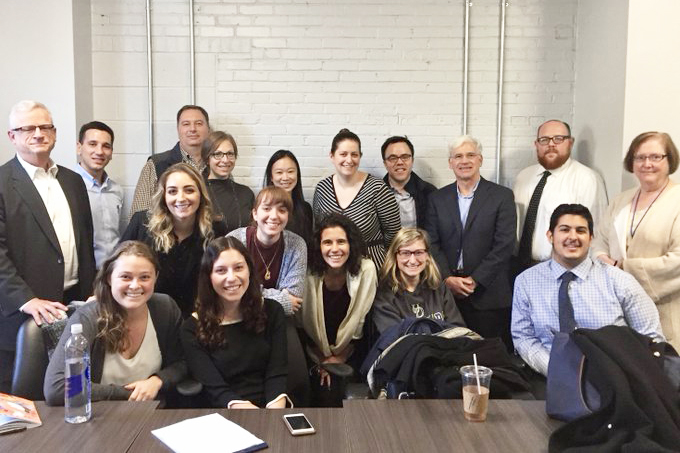Thanks to an initiative engineered by Professor Cheryl Bratt two years ago, students in her Law Practice course have been given an opportunity—rare for 1Ls nationwide—to apply lessons learned in her classroom to hands-on client work.
In her recent article, “Livening Up 1L Year: Moving Beyond Simulations to Engage 1L Students in Live-Client Work” in The Second Draft, the journal of the Legal Writing Institute, Bratt describes both what inspired her and what she’s done to incorporate experiential learning into her legal reasoning, research, and writing courses, which provide a foundation in critical thinking, analysis, and communication.
It all started when Bratt noticed, in teaching her classes, that there was a dearth of opportunities for 1Ls to engage with real clients who have genuine legal dilemmas. This despite the fact that the ABA, various states, and third-party reports emphasize the importance of experiential education. She also observed that law students crave these experiences, particularly in their first year, when they are eager to practice new skills and to feel connected to their reasons for attending law school in the first place.
Bratt’s quest to provide such training led to a partnership with the local nonprofit, Lawyers Clearinghouse, which engages the private bar in pro bono direct-services representation of homeless and low-income individuals. Fellow BC Law professor Maureen Van Neste describes the alliance as “a truly fantastic collaboration.”
Through participation in the program, Bratt’s students support members of the private bar who are providing the services. They hone core skills learned in the Law Practice course, including interviewing clients, providing oral reports to supervising attorneys, and drafting professional email interview summaries.
“This experience benefits in myriad ways my students, the participating attorneys, and Lawyers Clearinghouse, while also improving our community at large,” Bratt says. The partnership develops the students’ lawyering skills and professional identities, builds empathy, grows their professional networks, and inspires a commitment to pro bono service. The bar benefits from free legal services and from making connections with 1L students who will soon be applying for jobs in their offices. And Lawyers Clearinghouse benefits by reaching more clients, while also imprinting on students the importance of pro bono work as a core part of a lawyer’s practice.
Even when Covid-19 put constraints on students’ face-to-face interactions with attorneys and clients this year, Bratt has been able to maintain the collaboration with Lawyers Clearinghouse by using Zoom in two different legal clinics.
The first is a CORI clinic in which students work with attorneys to counsel clients on how to seal their criminal records. The clinic requires the students to learn various aspects of Massachusetts law related to record-sealing, write a strategy memo to the lawyer team, and then, together with the lawyers, advise their clients on their various avenues for relief. “The students have found this to be an incredibly rewarding experience,” Bratt says. “By helping clients seal their records, the students are better equipping their clients to secure housing, find employment, and, most generally, break from being defined by their past.”
In the second clinic, which is the one Bratt writes about in The Second Draft, students and attorneys meet (these days remotely) with clients and interview them to learn about the client’s legal dilemma. The students then participate in a case rounds discussion with the volunteer lawyers and Lawyers Clearinghouse staff and orally present their clients’ stories and the help needed. Finally, the students write summaries that are passed on to the lawyers who will take those clients’ cases.
Bratt’s programs yield significant benefits to all the parties involved, much to the delight of the students and fellow Boston College Law School faculty members.
In reflecting on her experience, one student remarked: “[T]he clinic helped to ‘re-focus’ my motivation and energy as we prepare for upcoming finals. … I chose to attend law school to gain the knowledge and skills necessary to advocate on behalf of others, particularly those who feel unheard. I have intentionally striven this semester to keep that motivation in mind, but the pressure of exams has at times taken the forefront. Participating in the clinic offered me an opportunity to recall my ‘why’ and also put it into practice.”
Another student also noted the networking benefits, on top of helping individual clients: “I was not only able to interact with an actual client, but could collaborate with two successful attorneys. Further, the attorneys that I worked with provided me with some great advice regarding law school, and noted that they were willing to answer any questions that I might have in the future. Additionally, working with two clients who wanted to improve their lives, and being in a position to actually help them was amazing. It showed me that, even as a 1L, I could use my position as a law student to help others.”
Professor Sharon Beckman’s comment summed up what many colleagues expressed to Bratt upon learning of her article and accomplishments: “This is such a great pedagogical innovation and wonderful that you wrote the paper sharing the idea with the legal academic community.”
Photo: Professor Cheryl Bratt, back row, fourth from left, with BC Law students, WilmerHale attorneys, and other clinic participants in 2018.


